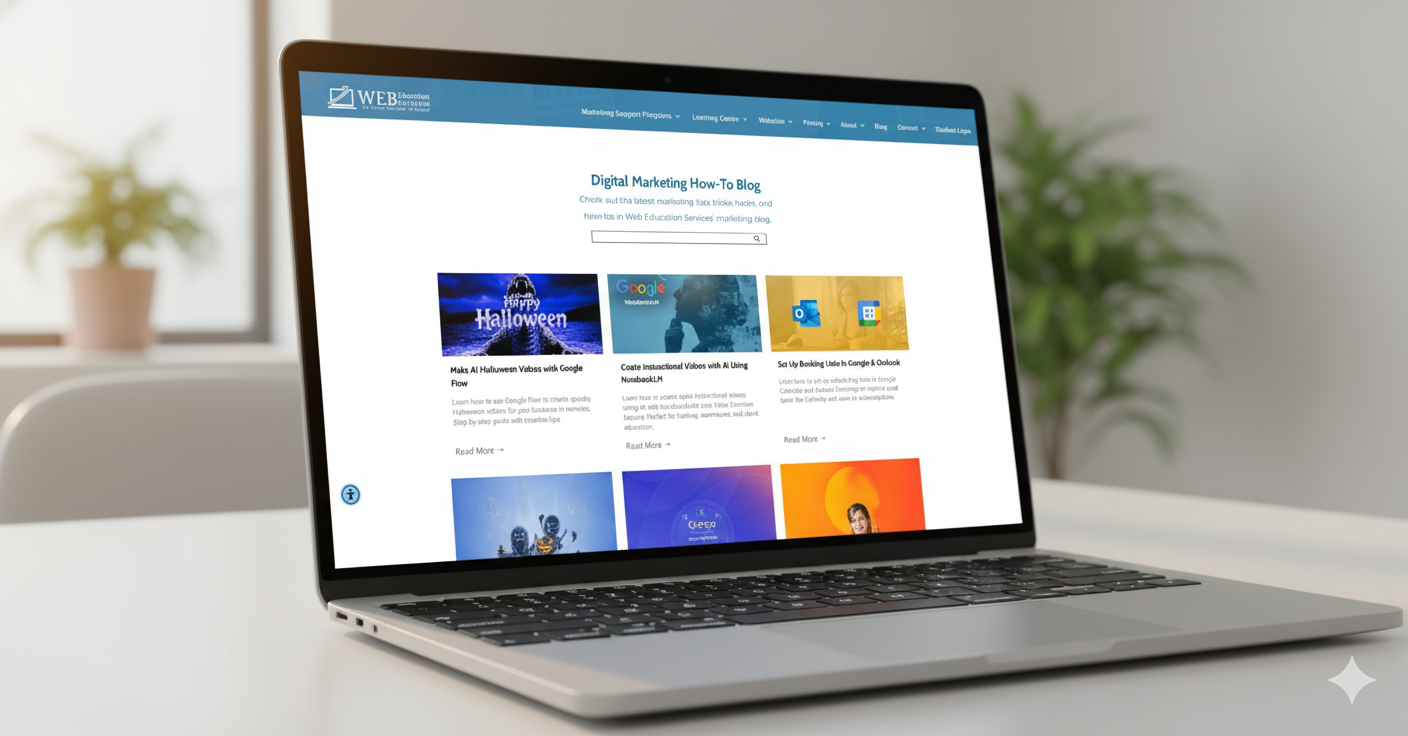Learn how to use Gemini, Google’s AI chatbot, including Deep Research, Veo video creation, Nano Banana image generation, Canvas, and Guided Learning tools.
Gemini vs. ChatGPT: Finding the Right AI Chatbot for You
AI chatbots are changing the way we work, learn, and create — but one of the biggest challenges isn’t which one is best, it’s which one is best for you.
At Web Education Services, we use both ChatGPT and Gemini, depending on what we’re trying to do. Sometimes we even prompt both tools the same way just to compare the results — and more often than not, we end up using a mix of both outputs.
That’s the beauty of today’s AI landscape: you don’t have to pick a side. Instead of asking, “Which chatbot is better?”, ask, “Which one helps me accomplish this task more effectively?”
If you’re curious about Google’s AI — Gemini — you’re not alone. Gemini has grown rapidly since its launch, integrating across Google’s entire ecosystem and introducing powerful creative tools that go beyond text. Let’s take a look at what Gemini does, how it compares, and how you can make the most of it.
What Is Gemini? An Overview of Google’s AI Chatbot
Gemini is Google’s family of generative AI models designed to understand text, images, video, and even code. Originally branded as Bard, it evolved into Gemini after Google merged the AI project under its DeepMind division, making it faster, smarter, and more integrated with Google Workspace.
Gemini now powers everything from Google Search enhancements to productivity tools in Docs, Sheets, and Gmail. But its standalone web app, Gemini.app, is where the magic happens.
Gemini 2.5 Flash and Pro
Gemini comes in multiple versions:
Gemini 2.5 Flash – optimized for speed and responsiveness. Perfect for quick queries, brainstorming, and lightweight content generation.
Gemini 1.5 Pro – designed for deeper reasoning, longer context (up to 1 million tokens in some versions), and professional-grade analysis.
Core Features Worth Exploring
Here are some of the standout tools in Gemini that make it more than just a chatbot:
- Deep Research – automatically conducts extended research in the background, summarizing credible sources.
- Videos with Veo – generate cinematic-quality videos using simple text prompts (Pro accounts only).
- Nano Banana – Gemini’s built-in image generation model that can create realistic images directly in chat.
- Canvas – a collaborative workspace for writing, brainstorming, and editing content visually.
- Guided Learning – step-by-step interactive tutorials for learning new skills inside Gemini.
Each of these features takes Gemini from a text-only chatbot to a complete creative and educational platform. Let’s unpack what makes each one valuable — and how you might use it in your business or creative workflow.
Why Deep Research Is a Feature — and How to Use It
If you’ve ever asked an AI a question and thought, “That sounds right, but I’m not sure it’s accurate,” you understand the need for Deep Research.
How Deep Research Works
Unlike standard chatbot answers that rely solely on trained data and general web patterns, Deep Research goes a step further. When you toggle it on, Gemini takes additional time to search, verify, and compile information from multiple sources before responding.
In other words, it acts like a research assistant who checks their work before handing it in. You’ll see citations, live web links, and a more nuanced answer — one that’s not just fast, but trustworthy.
When to Use Deep Research
Here are a few examples where Deep Research really helps:
For Web Education Services clients, we often use Gemini’s Deep Research alongside ChatGPT’s internal reasoning. ChatGPT gives us the creative structure, while Gemini verifies and supplements with current data — a powerful combo for marketing and strategy work.
Videos with Veo: Google’s Answer to AI Video Creation
AI-generated video is the next big wave, and Google’s Veo model — integrated into Gemini for Pro users — makes that accessible to creators who don’t have a full production team.
How Veo Works
Veo allows you to describe a scene, mood, or concept in plain language, and it generates cinematic-quality video clips from your prompt. You can even specify lighting, camera angles, or visual tone.
For example:
“Create a 10-second video of a runner on a sunrise beach with cinematic slow motion and lens flare.”
Gemini will render a realistic, stylized clip you can preview and refine with follow-up prompts.
What You Can Use It For
- Marketing and ads: Create product videos or brand intros.
- Education: Visualize lessons or concepts for tutorials.
- Social media: Generate short-form content fast, with minimal editing.
At Web Education Services, we see this becoming a huge part of content marketing workflows — especially when paired with Gemini’s text and image features. It lets small teams produce professional-looking video assets without breaking the budget.
Nano Banana: Image Creation in Gemini
Yes, the name sounds playful — but Nano Banana is a serious creative engine. This is Gemini’s internal image generation system, capable of producing detailed, photo-realistic visuals directly in chat.
How Nano Banana Works
Type a simple prompt like:
“Generate an image of a futuristic classroom with students using tablets.”
Within seconds, Gemini’s Nano Banana engine delivers multiple variations. You can refine the style (realistic, watercolor, 3D render), aspect ratio, and composition using follow-up prompts.
While Google hasn’t confirmed all technical details, Nano Banana is believed to build on Imagen 3 — Google’s advanced diffusion model.
What You Can Use It For
- Blog graphics and
social media visuals
- Ad creative concepts
- Website design mockups
- Training materials
You can also export these images directly into your Canvas workspace or download them for use elsewhere.
For marketers, this means Gemini can now generate your blog content, design your featured image, and even create a supporting video — all in one place.
Canvas: A Collaborative Workspace Inside Gemini
One of Gemini’s most overlooked features is Canvas, which bridges the gap between brainstorming and creation.
How Canvas Works
Instead of typing in a chat window, Canvas gives you a split-screen interface: AI-generated text on one side and an editable workspace on the other. You can drag, drop, edit, and refine sections visually — similar to Google Docs, but smarter.
Gemini can:
What You Can Use It For
- Writing blogs, emails, and website content.
- Planning outlines or scripts.
- Editing collaboratively with AI.
This is especially useful for content teams who want a visual way to work with AI-generated text. You can even copy your Canvas content straight into your CMS (like Duda, WordPress, or HubSpot) once it’s ready for publishing.
Guided Learning: Learn by Doing Inside Gemini
Perhaps the most unique feature in Gemini is Guided Learning — a built-in system that teaches you new skills through interactive steps.
How Guided Learning Works
Guided Learning transforms Gemini into a personalized tutor. Instead of giving you static answers, it walks you through processes with checkpoints.
Example prompt:
“Teach me how to create a Google Ads campaign.”
Gemini will break the process into steps, prompting you to complete each action before continuing — just like a live instructor would.
What You Can Use It For
- Learning new software or tools (like Google Sheets formulas or SEO research).
- Developing marketing skills like keyword strategy or ad setup.
- Personal growth and education, from languages to presentation skills.
This is where Gemini really differentiates itself from other chatbots. It’s not just doing things for you — it’s teaching you how to do them. That aligns perfectly with our mission at Web Education Services: We teach you how to market.
Why We Use Both ChatGPT and Gemini
At Web Education Services, we’re constantly testing new tools. Some tasks are better suited for ChatGPT, while others shine in Gemini. Here’s a quick comparison based on how we use them:
| Task | Best Tool | Why |
|---|---|---|
| Creative brainstorming | ChatGPT | Natural, conversational flow |
| Visual content creation | Gemini | Nano Banana + Veo |
| Long-form SEO blogs | ChatGPT | Follows structure & readability rules |
| Research and fact-checking | Gemini | Deep Research and source citations |
| Learning and tutorials | Gemini | Guided Learning |
| Automation and workflows | ChatGPT | Integrates with Zapier, Duda, HubSpot |
| Client presentations | Gemini | Embedded visuals and Canvas layout |
In short, you don’t have to choose. You just have to know what each does best — and use that to your advantage.
How to Access Gemini and Get Started
You can access Gemini directly atgemini.google.com/app.
To unlock all features — including Veo video generation and Canvas collaboration — you’ll need a Google One AI Premium subscription, which also integrates Gemini into Gmail, Docs, and Sheets.
Once you’re in, start experimenting. Try prompting it with your business’s real challenges:
- “Create a social post about my new product launch.”
- “Summarize my website analytics and recommend improvements.”
- “Design a sample image for a Facebook ad.”
Within minutes, you’ll see how Gemini adapts to your workflow and helps you turn ideas into action.
Final Thoughts: AI Isn’t About Picking Sides
AI tools like Gemini and ChatGPT aren’t competitors — they’re collaborators. Each offers unique strengths that help you think faster, create better, and learn more efficiently.
At Web Education Services, we believe in testing, comparing, and teaching others how to get the most out of each platform. Whether you’re a business owner trying to simplify your marketing or a content creator looking for creative edge, Gemini deserves a spot in your toolbox.
💡 Join us this Friday at 2 PM for our free weekly workshop!
We’ll walk through Gemini’s features live, show how to use ChatGPT alongside it, and demonstrate how AI tools can transform your marketing workflow.










